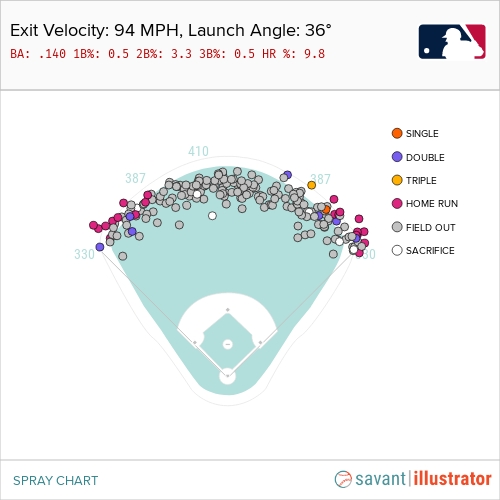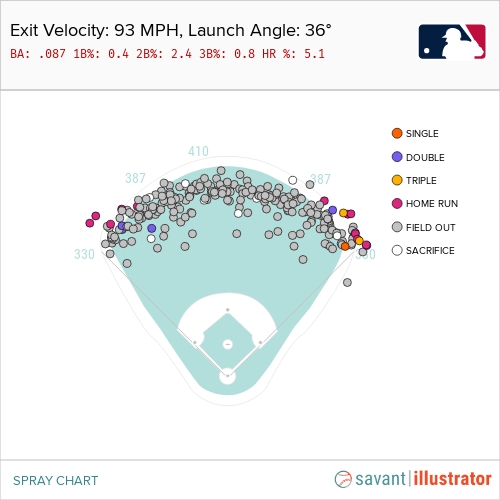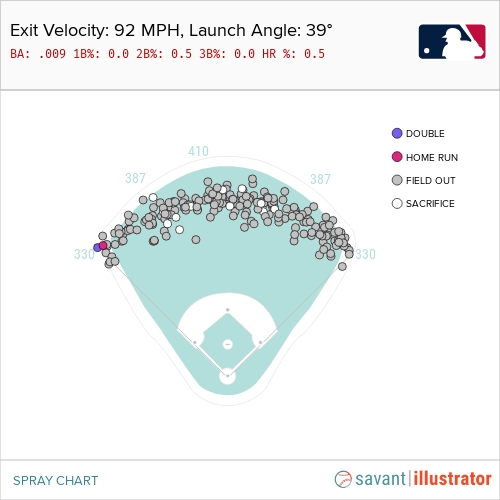Shortstop is quite the deep position these days, so much so that a player such as Paul DeJong of the St. Louis Cardinals perhaps gets a bit underrated in the grand scheme of things. While DeJong doesn’t have the most glamorous of profiles and isn’t considered in the top tier of shortstops, he has shown the ability to be a good source of counting stats over the course of his first four Major League seasons, with a rate of 30 home runs and 90 RBI per 162 games. It’s not a complete profile, as he has been missing that extra bit in terms of batting average thus far in his career, but DeJong still is, without a doubt, a solid offensive player.
2020 Woes
His 2020 season, however, was a disaster. The Cardinals’ season was a bit of an altogether mess, as the team experienced a COVID outbreak that forced them to miss a lot of time, and they made up for that missed time with a brutal schedule down the stretch, which consisted of many doubleheaders.
That certainly didn’t do many favors for DeJong, who was one of the many Cardinals players to test positive for COVID, and not only had to deal with the effects of that, but also the recovery process, and then once back on the field, trying to hit against top Major League pitching. It wasn’t an easy situation, and DeJong’s subpar .250/.322/.349 triple slash from a season ago can definitely be excused a bit.
While his 2020 stats were ugly, there were still some positives to take away and also help show that DeJong should rebound this season. First off, DeJong continued to hit the ball hard, as both his average exit velocity and hard-hit rates were better than his career averages:
| Season | AVG EV | Hard-Hit% |
|---|---|---|
| 2017 | 86.5 | 39.5 |
| 2018 | 89.3 | 40.1 |
| 2019 | 87.0 | 32.5 |
| 2020 | 89.2 | 40.6 |
| Career AVG | 87.7 | 37.1 |
Those rates from 2020 won’t set the world on fire—they were roughly around league average last season—but still, it is good to see that even while he was struggling for most of the season, he continued to hit the ball hard and better than most of his previous seasons.
Not just that, but his batted-ball profile remained true to form. Historically, DeJong has been able to get a good amount of batted balls in the air, which was the case in 2020. His struggles weren’t the fault of an increased rate of balls being hammered into the ground, for instance. In fact, his groundball rate declined by almost ten percent last year, which looks quite good.
He also continued to show decent enough plate discipline with an above-average 9.8% walk rate. He was striking out more, which looks mostly to be due to a decreased rate of contact rather than chases:
| Season | K% | Z-Contact% | Whiff% | Chase% |
|---|---|---|---|---|
| 2017 | 28.0 | 79.6 | 27.9 | 30.2 |
| 2018 | 25.2 | 83.9 | 25.4 | 25.3 |
| 2019 | 22.4 | 83.9 | 24.2 | 28.1 |
| 2020 | 28.7 | 79.1 | 32.3 | 24.3 |
While it’s not exactly a great thing to see more whiffs, the hope should be that in a more normal season without all of the chaos and uncertainty that DeJong and the Cardinals dealt with, that this should return back to his career norms, but that remains to be seen. The main point should still be that DeJong shouldn’t have an issue taking a walk when given the opportunity, which is ultimately a positive.
Flyball Follies
What does look the oddest about DeJong’s season, though, was that his HR/FB rate was cut by more than half from where it was in 2019:
| Season | HR/FB% |
|---|---|
| 2017 | 19.8 |
| 2018 | 13.6 |
| 2019 | 15.4 |
| 2020 | 6.4 |
DeJong’s 16.1% HR/FB rate from 2017 to 2019 was quite good in the grand scheme of things, especially for a shortstop. For that strong rate to all of a sudden decrease as much as it did last season compared to previous years gives us a pretty good explanation as to why DeJong struggled so much in the power department last season. We know DeJong continued to be who he was naturally at the plate last season—meaning he held true to his fly ball heavy profile—those balls just weren’t clearing the fence at as high a rate as in the past.
In fact, in terms of hitters with at least 130 plate appearances last season, DeJong’s 6.4% HR/FB rate was actually the fifth-lowest, which is quite the fall. There must have been something going on with his fly balls last season to go from such a positive in that area to such a negative. Bouncing back in this area will be crucial for DeJong to get back to the type of hitter he has been previously. Let’s see what exactly was up with DeJong’s fly balls last year.
In trying to find the answer, it seems logical to start by investigating how DeJong was hitting his fly balls. To start, let’s take a look at DeJong’s average exit velocity on fly balls. DeJong wasn’t bad in this area last season—he was actually right around average. However, his 2020 mark was a bit off from where it was previously in his career:
| Season | AVG FB EV |
|---|---|
| 2017 | 93.7 |
| 2018 | 93.6 |
| 2019 | 92.8 |
| 2020 | 91.7 |
And with that drop in exit velocity was a drop in average distance:
| Season | AVG FB Dist. |
|---|---|
| 2017 | 330 |
| 2018 | 332 |
| 2019 | 333 |
| 2020 | 314 |
Those are two pretty big red flags right there and seem to be a good step forward in terms of finding out why his fly balls weren’t clearing the fence at such a high rate last year. We can still drill down further, though, and take a look at his rate of hard-hit fly balls. After all, hitting a lot of fly balls doesn’t guarantee a lot of home runs on its own; rather, hard-hit fly balls have a better chance of clearing the fence. Looking at DeJong’s rate for his career shows the following:
| Season | HH FB | Total FB | HH FB% |
|---|---|---|---|
| 2017 | 40 | 76 | 52.6% |
| 2018 | 53 | 91 | 58.2% |
| 2019 | 52 | 119 | 43.7% |
| 2020 | 13 | 31 | 41.9% |
While we see that DeJong’s rate last season was the lowest of his career, it is important to note that DeJong was still better than the league average rate of around 37%. While his 2020 mark isn’t too far off from where it was in 2019, it is quite substantial when compared to where it was in 2018 in this department.
Angles and Barrels
However, what may be more substantial when looking even further is DeJong’s barrel rate. It is important to note that DeJong’s barrel rate last season was a career-low at 7.5%, and this decrease in barrel rate really stands out when looking at the number of fly balls DeJong managed to barrel up last season compared to previous years. Here is a table showing two things: barreled fly balls as a percentage of both total barrels and total fly balls for DeJong over the course of his career. Either way you look at it, DeJong was off in this area last season:
| Season | BRL FB | Total BRL | BRL FB / Total BRL % | Total FB | BRL FB / Total FB % |
|---|---|---|---|---|---|
| 2017 | 21 | 27 | 77.8% | 76 | 27.6% |
| 2018 | 25 | 30 | 83.3% | 91 | 27.5% |
| 2019 | 32 | 37 | 86.5% | 119 | 26.9% |
| 2020 | 3 | 8 | 37.5% | 31 | 9.7% |
DeJong had been pretty consistent here for most of his career. Pretty much all of his barrels had been on fly balls, and over a quarter of his fly balls hit were considered barrels, but in 2020 that regressed tremendously. This is, perhaps, a good explanation as to why DeJong wasn’t able to clear the fence as often as we’ve come to expect.
Again, it is a small sample, and there is a good chance that this would have trended back to his career norms with more games, but it is important to keep in mind that while we want hitters to get the ball in the air more, not all fly balls are created equal. To hit a fly ball over the wall, it generally needs to be hit pretty well. When looking at Statcast hit probabilities, it is clear that certain fly balls at certain launch angles play more in terms of wOBA and expected batting average, and a lot of others generally don’t.
How does this relate to DeJong? Well, the average launch angles of his fly balls throughout his career have remained steady for the most part, even during his down 2020:
| Season | AVG FB LA |
|---|---|
| 2017 | 38 |
| 2018 | 36 |
| 2019 | 36 |
| 2020 | 39 |
It is true that balls hit at 36 degrees, as DeJong averaged in both 2018 and 2019, tend to get better results than those hit at 39 degrees, but the differences are usually small. However, what can make a difference is what happens when a ball hit at 39 degrees is hit hard compared to one that isn’t, and remember, DeJong didn’t hit his fly balls super hard last year. Using the same Statcast hit probability tool, we can see the results for balls hit at both DeJong’s average fly ball launch angle and exit velocity (as shown in a previous table). First up, 2018 and 2019:


They don’t look overly impressive on their own, and that’s okay, as they are just the averages. Most hitters’ averages wouldn’t look all that strong on a chart like this. But, they do look much better than what DeJong’s 2020 averages look like when on the same chart:

Balls hit at DeJong’s average fly ball angle and exit velocity the last three seasons don’t go for hits very often at all, but at 2020’s averages, they go for hits hardly ever and with a very little home run chance when compared to the other two. This is essentially just a visual way of showing what DeJong’s main problem was the last season: he wasn’t hitting his fly balls hard enough. Fly balls are supposed to be good; that is unless they’re hit either too weakly or too high, and for DeJong last season, he was doing both. That had an obvious impact on his overall performance.
That’s mostly what the problem was for DeJong last season, but that’s not entirely it. Looking back again to DeJong’s batted-ball distribution for his career, we see that he has hit a high amount of popups over the years, with a career 11.3% rate and a 10.4% rate last season.
That’s already a high amount, but now factor in that DeJong hit quite a few fly balls last season that were essentially popups but don’t get classified as such because they reached the outfield. For instance, here’s a ball that was hit hard at 97 mph but at a 57-degree launch angle. It’s classified as a fly ball, but it’s an easy out and would pretty much be an automatic out every single time:
And here’s one more example. This time, another one hit hard at 95 mph, but at a similar 57-degree angle that isn’t much of a challenge for the fielder:
Those are just two examples, but there are a few other examples from last season that we could look at. The point should be clear, though. A few of DeJong’s hard-hit balls were essentially popups, which were easy outs. When this is combined with an already high rate of popups, it equals a lot of outs made that were pretty much automatic, which is definitely not ideal.
The overall theme is that for a hitter that relies so much on getting the ball in the air as DeJong does, there’s very little room for error. Fly balls usually don’t do much for a hitter’s BABIP, and the ultimate goal of fly balls is for them to go over the fence or for extra bases, but that usually only happens when they’re hit hard. This got away from DeJong last season, and that contributed to his lackluster performance, driven by a dramatic decrease in his HR/FB rate.
Of course, his 2020 season can and should be discounted some due to multiple factors which were discussed earlier. This is, however, an area that should be kept in mind and tracked when evaluating DeJong’s performance this season. The 2021 season is still way too young to make any general assessments, but there are already some positive signs for DeJong in this department.
First, his maximum exit velocity is already a four-mph improvement over where it was in 2020, and the two home runs that he’s hit were both classified as barrels per Statcast, including this no-doubter hit at an encouraging 108.4 mph and at a 34-degree launch angle:
With more of those from DeJong this season, he’ll have us all forgetting about his down 2020 season in no time.
Photo by John Adams/Icon Sportswire | Design by Aaron Polcare

